Beyond CPAP
March 06, 2022

Latest treatment options for obstructive sleep apnea
CPAP, a device that uses air pressure to open the upper airway as you sleep, has been the mainstay therapy to treat obstructive sleep apnea since the 1980s.
Yet technological innovations in recent years have spawned many more treatment options for sleep apnea.
The disorder is very common, especially among older men and those who are obese. It happens when muscles in the back of the throat relax and partially block the upper airway while you sleep, causing intermittent breathing and snoring. It often leads to daytime sleepiness and, if untreated, will elevate risk of high blood pressure, weight gain, heart problems and diabetes.
Newer therapies include oral devices, nerve stimulation devices that open the airway and an electrical stimulator used during waking hours to train the tongue and upper airway.
“For any moderate to severe obstructive sleep apnea, CPAP should be the first choice,” says UH sleep medicine specialist Ambrose Chiang, MD. “But there are multiple new FDA-cleared devices that can be tried out these days.”
The best option for any patient depends on the severity of their disorder, whether the patient is obese and how they fare using CPAP (Continuous Positive Airway Pressure), Dr. Chiang says.
Patients with mild sleep apnea might not need treatment, but a doctor may recommend steps such as losing excess weight, exercising, sleeping on the sides or in a reclining position, and avoiding alcohol in the hours before bedtime.
Dr. Chiang breaks down the various treatment options:
CPAP delivers air pressure through a mask to keep the upper airway open.
Sometimes it takes an adjustment period, and patients often give up too early, Dr. Chiang says. Patients frequently report discomfort or find it difficult to sleep tethered to a CPAP machine.
“There’s a need for a lot of troubleshooting to make CPAP work,” he says. “We can change the mask, we can change pressure, we can increase humidity. There are a lot of things we can do so that the patient keeps using the device.”
Oral devices may be recommended for patients with mild to moderate sleep apnea. Customized oral devices, sometimes called oral or dental appliances, move the jaw forward to create space behind the tongue.
They are recommended for patients who cannot tolerate CPAP or who are looking for an alternative to CPAP, Dr. Chiang says.
Sleep specialists work with dental sleep specialists, who make sure teeth are in good condition and custom fit the devices. An oral device may require adjustment after a patient starts using it.
Many patients prefer oral devices, but they can cause problems for some, Dr. Chiang says.
“They can cause facial pain, potential problems with joints connecting the jaw and skull (temporomandibular joints), or result in shifting teeth over time,” he says.
Nerve stimulation involves implanting a small device like a pacemaker into the right side of the chest to stimulate the nerve controlling the tongue and open the airway in sleep.
The therapy is for patients with moderate to severe sleep apnea who have failed CPAP. Patients who are obese with body mass index above 35 don’t qualify for the therapy.
“They have to be thin enough to be a potential candidate,” Dr. Chiang says.
The FDA approved the first such stimulation device, called Inspire, in 2014.
Bariatric surgery may be recommended for obese patients with obstructive sleep apnea, Dr. Chiang says.
“If we can help them lose weight, sleep apnea often gets better,” he says. “It will also take care of a lot of other medical issues such as diabetes and high blood pressure at the same time.”
Other emerging therapies include EPAP (expiratory positive airway pressure) devices that fit in or over the nostrils. A valve creates pressure in the back of the throat when a patient exhales, opening the airway. Also, in 2021, the FDA authorized a daytime treatment called eXciteOSA for snoring and mild obstructive sleep apnea.
Neither of these therapies are covered by insurance, Dr. Chiang says.
At one time, doctors might recommend surgery to remove excess tissue in the back of the throat. But Dr. Chiang says surgery is no longer recommended for most patients.
“Surgery is the last resort,” he says. “It’s not very effective and there are many other, less invasive options these days.”
Ambrose Chiang, MD is a sleep medicine specialist at University Hospitals Cleveland Medical Center. For more information on sleep apnea, call 216-844-REST.


